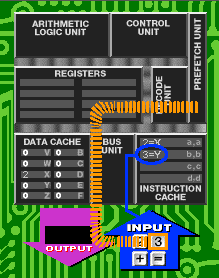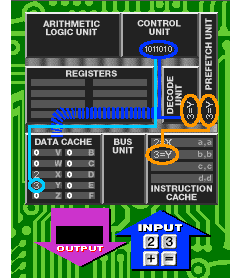When you press the 3 key, the Prefetch Unit asks the computer's main memory and the Instruction Cache for specific instructions on this new data. No matching instruction is found in the Instruction Cache so the instruction will come from the main memory. Similar to "2=X," the new data instructions come into the microprocessor from the computer's main memory and get stored in an Instruction Cache address where it is assigned the code "3=Y." The Prefetch Unit then pulls a copy of the code "3=Y" from the Instruction Cache and sends it to the Decode Unit for further processing. In the Decode Unit the instruction "3=Y" is translated or decoded into a string of binary code that is sent off to the Control Unit and the Data Cache to tell them what to do with the instruction. Because the Decode Unit figured out that the number 3 was to be stored for the future in the Data Cache, the Control Unit now performs the instruction for "3=Y." This causes the number 3 to be sent to an address in the Data Cache called "Y," where it waits like the "2" for further orders. |
  |